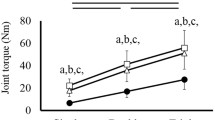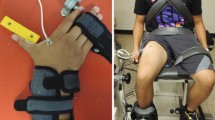Abstract
A mathematical model of the locust hind leg extensor muscle is described. The model accounts for the force response of the muscle to well-separated input stimuli under isometric conditions. Experimental data was collected by stimulating the extensor muscle and measuring the force generated at the tibia. In developing a model it was assumed that the response to a single isolated stimulus was linear. A linear model was found to fit well to the response to an isolated stimulus. No assumptions were made about the model order and models of various order were fitted to data in the frequency domain, using a least squares fit. The stimulus can be approximated as an impulse, with the response to each stimulus well described by a linear second-order system. Using a third-order model provided a better fit to data, but the improvement in fit was marginal and the model uses one extra parameter. A fourth-order model, which is often used to describe the behaviour of isometric muscle was found to overfit the data. Using a second-order model provides a simpler way of describing the behaviour of an isometric twitch.
Similar content being viewed by others
References
Ahn AN, Full RJ (2002) A motor and a brake: two leg extensor muscles acting at the same joint manage energy differently in a running insect. J Exp Biol 205: 379–389
Alexander RM (2003) Modelling approaches in biomechanics. Philos Trans R Soc Lond Biol Sci 358: 1429–1435
Baratta R, Solomonow M (1990) The dynamic response model of nine different skeletal muscles. IEEE Trans Biomed Eng 37(3): 243–251
Bawa P, Mannard A, Stein RB (1976a) Effects of elastic loads on the contractions of cat muscles. Biol Cybern 22(3): 129–137
Bawa P, Mannard A, Stein RB (1976b) Predictions and experimental tests of a visco-elastic muscle model using elastic and inertial loads. Biol Cybern 22(3): 139–145
Bennet-Clark HC (1975) The energetics of the jump of the locust schistocerca gregaria. J Exp Biol 63: 53–83
Bernotas LA, Crago PE, Chizeck HJ (1986) A discrete-time model of electrically stimulated muscle. IEEE Trans Biomed Eng 33(9): 829–838
Biewener AA (2003) Animal locomotion. Oxford University Press, New York
Bobet J, Stein RB (1998) A simple model of force generation by skeletal muscle during dynamic isometric contractions. IEEE Trans Biomed Eng 45(8): 1010–1016
Bobet J, Stein RB, Oguztoreli MN (1993) A linear time-varying model of force generation in skeletal muscle. IEEE Trans Biomed Eng 40(10): 1000–1006
Bobet J, Gossen ER, Stein RB (2005) A comparison of models of force production during stimulated isometric ankle dorsiflexion in humans. IEEE Trans Neural Syst Rehabil Eng 13(4): 444–451
Burnham KP, Anderson DR (1998) Model Selection and Multimodel Inference A Practical Information—Theoretical Approach. Springer, New York. Second Edition
Burns MD, Usherwood PNR (1978) Mechanical-properties of locust extensor tibiae muscles. Comparative Biochemistry and Physiology a-Physiology 61(1): 85–95
Burrows M (1996) The Neurobiology of an Insect Brain. Oxford University Press, New York
Burrows M, Horridge GA (1974) The organization of inputs to motoneurons of the locust metathoracic leg. Philos Trans R Soc Lond B Biol Sci 269: 49–94
Burrows M, Morris G (2001) The kinematics and neural control of high-speed kicking movements in the locust. J Exp Biol 204: 3471–3481
Ding J, Wexler AS, Binder-Macleod SA (2002) A mathematical model that predicts the force-frequency relationship of human skeletal muscle. Muscle Nerve 26(4): 477–485
Durfee WK, Palmer KI (1994) Estimation of force-activation, force-length, and force-velocity properties in isolated, electrically stimulated muscle. IEEE Trans Biomed Eng 41(3): 205–216
Frey Law LA, Shields RK (2005) Mathematical models use varying parameter strategies to represent paralyzed muscle force properties: a sensitivity analysis. J NeuroEng Rehabil 2(12): 18
Gabriel JM (1985) The development of the locust jumping mechanism II. Energy storage and muscle mechanics. J Exp Biol 118: 327–340
Ghigliazza R, Holmes P (2005) Towards a neuromechanical model for insect locomotion: hybrid dynamical systems. Regul Chaotic Dyn 10(2): 193–225
Gollee H, Hunt KJ (1997) Nonlinear modelling and control of electrically stimulated muscle: a local model network approach. Int J Control 68(6): 1259–1288
Gollee H, Murray-Smith DJ, Jarvis JC (2001) A nonlinear approach to modeling of electrically stimulated skeletal muscle. IEEE Trans Biomed Eng 48(4): 406–415
Guschlbauer C, Scharstein H, Buschges A (2007) The extensor tibiae muscle of the stick insect: biomechanical properties of an insect walking leg muscle. J Exp Biol 210: 1092–1108
Hatze H (1977) A myocybernetic control model of skeletal muscle. Biol Cybern 25(2): 103–119
Heitler WJ (1977) Locust jump : III. Structural specializations of metathoracic tibiae. J Exp Biol 67: 29–36
Hoyle G (1955a) The anatomy and innervation of locust skeletal muscle. Proc R Soc Lond Biol Sci 143: 281–292
Hoyle G (1955b) Neuromuscular mechanisms of a locust skeletal muscle. Proc R Soc Lond Biol Sci 143: 343–367
Hoyle G (1978) Distributions of nerve and muscle fibre types in locust jumping muscle. J Exp Biol 73: 205–233
Huijing PA (1995) Parameter interdependence and success of skeletal muscle modelling. Hum Mov Sci 14: 443–486
Hunt KJ, Munih M, Donaldson NN, Barr FM (1998) Investigation of the hammerstein hypothesis in the modeling of electrically stimulated muscle. IEEE Trans Biomed Eng 45(8): 998–1009
Huxley AF (1974) Muscular contraction. J Physiol 243(1): 1–43
Lieber RL (2002) Skeletal muscle structure, function and plasticity: the physiological basis of rehabilitation, 2nd ed. Lippincott Williams & Wilkins, USA
Ljung L (1999) System identification theory for the user, 2nd ed. Prentice Hall, Englewood Cliffs,NJ
Mannard A, Stein RB (1973) Determination of the frequency response of isometric soleus muscle in the cat using random nerve stimulation. J Physiol 229: 275–296
Parmiggiani F, Stein RB (1981) Nonlinear summation of contractions in cat muscles. ii. later facilitation and stiffness changes. J Gen Physiol 78: 295–311
Raikova R, Celichowski J, Pogrzebna M, Aladjov H, Krutki P (2007) Modeling of summation of individual twitches into unfused tetanus for various types of rat motor units. J Electromyogr Kinesiol 17(2): 121–130
Raikova R, Pogrzebna M, Drzymala H, Celichowski J, Aladjov H (2008) Variability of successive contractions subtracted from unfused tetanus of fast and slow motor units. J Electromyogr Kinesiol 18(5): 741–751
Riener R, Quintern J (1997) A physiologically based model of muscle activation verified by electrical stimulation. Bioelectrochem Bioenerg 43: 257–264
Squire LR, Bloom FE, Spitzer NC, du Lac S, Ghosh A, Berg D (2008) Fundamental neuroscience, 3rd ed. Elsevier, Amsterdam
Stein RB, Parmiggiani F (1981) Nonlinear summation of contractions in cat muscles. i. Early depression. J Gen Physiol 78(3): 277–293
Wilson E, Rustighi E, Mace BR, Newland PL (2009) A model of force generation by locust skeletal muscle in response to individual stimuli. In: Proceedings of the ASME 2009 IDETC/CIE, San Diego, USA. ASME
Winters JM (1995) How detailed should muscle models be to understand multijoint movement coordination. Hum Mov Sci 14: 401–442
Zajac FE (1989) Muscle and tendon: properties, models, scaling, and application to biomechanics and motor control. Crit Rev Biomed Eng 17(4): 359–411
Zakotnik J (2006) Biomechanics and neural control of targeted limb movements in an insect, Ph. D. thesis. University of Bielfield, Bielfield
Zakotnik J, Matheson T, Durr V (2006) Co-contraction and passive forces facilitate load compensation of aimed limb movements. J Neurosci 26: 4995–5007
Zhou BH, Solomonow M, Baratta R, D’Ambrosia R (1995) Dynamic performance model of an isometric muscle-joint unit. Med Eng Phys 17(2): 145–150
Author information
Authors and Affiliations
Corresponding author
Rights and permissions
About this article
Cite this article
Wilson, E., Rustighi, E., Mace, B.R. et al. Isometric force generated by locust skeletal muscle: responses to single stimuli. Biol Cybern 102, 503–511 (2010). https://doi.org/10.1007/s00422-010-0382-x
Received:
Accepted:
Published:
Issue Date:
DOI: https://doi.org/10.1007/s00422-010-0382-x




